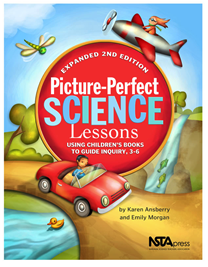by guest-blogger Emily Morgan
 |
| Click to buy! |
Here’s what we’ve been doing in the days after the eclipse:
Observations: First, we discussed our
observations – the orange and black circles overlapping in our solar eclipse
glasses, the sky getting darker, the air around us getting cooler, and so on.
We talked about how the Sun looked was a crescent shape during the eclipse,
which then led us into a discussion about the Moon’s different shapes, or phases.
 |
| Click to go to view video on YouTube. |
Read-Aloud: After the activity, we read the
book Next Time You See the Moon and refer to the
Styrofoam ball modeling activity throughout the read-aloud. The book explains
that the Moon’s phases are caused by the Moon’s orbit around the Sun – that
half of the Moon is always lit by the sun, and we see different parts of the
side reflecting light as the Moon travels around our planet.
Modeling the Eclipse: After the read-aloud, students were challenged to use the same Sun-Moon-Earth model to represent a solar eclipse. Students were given time to figure out that the Moon must be positioned between the Sun and the Earth during a solar eclipse and that in order for the Moon to be in that position, it must be a New Moon. We also observed the circular shadow of the Moon on Earth (our faces) during a solar eclipse and discussed the fact that the solar eclipse was not visible to everyone on Earth, just those of us in the shadow. Finally, we watched satellite footage of the Moon’s shadow moving across the United States on August 21st and related that footage to our model.
 |
| Modeling the eclipse. |
More Questions: As always with science, the more
you learn, the more questions you have, so we generated and explored more
questions like:
• Why don’t we have a solar eclipse at every New Moon?
• How often does a solar eclipse happen?
• How does the size of the Moon compare to the size of the Sun?
• How far away are the Sun and the Moon from Earth?
I hope you will consider trying this modeling activity with your students, and I hope that the wonder of the Great American Eclipse stays with you all for a very long time.
• Why don’t we have a solar eclipse at every New Moon?
• How often does a solar eclipse happen?
• How does the size of the Moon compare to the size of the Sun?
• How far away are the Sun and the Moon from Earth?
 |
| Click to buy! |
I hope you will consider trying this modeling activity with your students, and I hope that the wonder of the Great American Eclipse stays with you all for a very long time.
If you'd like a complete 5-E lesson (Engage, Explore, Explain, Elaborate, Evaluate) about the phases of the Moon, see Chapter 17: The Changing Moon in Picture-Perfect Science Lessons from NSTA Press.
No comments:
Post a Comment